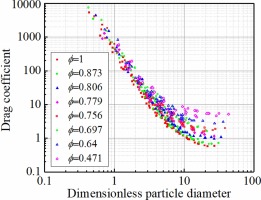Particuology ( IF 4.1 ) Pub Date : 2018-12-24 , DOI: 10.1016/j.partic.2018.07.006 Zhengming Xu , Xianzhi Song , Gensheng Li , Zhaoyu Pang , Zhaopeng Zhu

|
Solid-particle settling occurs in many natural and industrial processes, such as in the transportation of drilling cuttings and fracturing proppant. Knowledge of the drag coefficient and settling velocity of cuttings and proppant is of significance to hydraulics design, wellbore cleanout, and fracture optimization. We conducted 553 tests to investigate the settling characteristics of spherical and non-spherical particles in power-law fluids. Three major particle shapes (spherical, cubic, and cylindrical) and eight different particle sphericities were used to simulate cuttings and proppant, and power-law fluids were applied to simulate drilling and fracturing fluids. Based on the data analysis, a new drag coefficient–particle Reynolds number correlation was developed to determine the drag coefficient in a power-law fluid for spherical and non-spherical particles. The drag coefficient increases as the sphericity decreases for the same particle Reynolds number. For a specific particle shape, the drag coefficient decreases as the particle Reynolds number increases, but the decreasing trend is reduced at high particle Reynolds number conditions. An explicit settling-velocity equation was proposed to calculate the settling velocity of spherical and non-spherical particles in power-law fluids by considering the effect of sphericity. A suitable range for the proposed model is 0.0001 < Re < 200, 0.471 < ϕ < 1, and 0.505 < n < 1. An illustrative example is presented to show how to calculate the drag coefficient and settling velocity in power-law fluids with given particle and fluid properties.
中文翻译:

幂律流体中非球形颗粒的沉降行为:实验研究和模型开发
固体颗粒沉降发生在许多自然和工业过程中,例如在钻屑和压裂支撑剂的运输中。钻屑和支撑剂的阻力系数和沉降速度的知识对于水力设计,井眼清理和裂缝优化具有重要意义。我们进行了553次测试,以研究幂律流体中球形和非球形颗粒的沉降特性。三种主要的颗粒形状(球形,立方和圆柱形)和八个不同的颗粒球形度被用于模拟钻屑和支撑剂,幂律流体被应用于模拟钻井和压裂流体。根据数据分析,开发了一种新的阻力系数-粒子雷诺数相关性,用于确定幂律流体中球形和非球形粒子的阻力系数。对于相同的粒子雷诺数,阻力系数随着球形度的降低而增加。对于特定的颗粒形状,阻力系数随颗粒雷诺数的增加而减小,但是在高颗粒雷诺数条件下,减小的趋势减小。提出了一个明确的沉降速度方程,通过考虑球形度的影响来计算幂律流体中球形和非球形颗粒的沉降速度。建议模型的合适范围是0.0001 < 阻力系数随着粒子雷诺数的增加而减小,但下降趋势在高粒子雷诺数条件下减小。提出了一个明确的沉降速度方程,通过考虑球形度的影响来计算幂律流体中球形和非球形颗粒的沉降速度。建议模型的合适范围是0.0001 < 阻力系数随着粒子雷诺数的增加而减小,但下降趋势在高粒子雷诺数条件下减小。提出了一个明确的沉降速度方程,通过考虑球形度的影响来计算幂律流体中球形和非球形颗粒的沉降速度。建议模型的合适范围是0.0001 < Re <200、0.471 < ϕ <1和0.505 < n <1。给出一个说明性示例,以显示如何在具有给定的粒子和流体特性的情况下,计算幂律流体中的阻力系数和沉降速度。











































 京公网安备 11010802027423号
京公网安备 11010802027423号